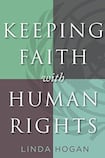
In September 1979 Pope John Paul II travelled from Shannon to New York, where he addressed the United Nations General Assembly. His speech is recalled to this day as a resounding endorsement of human rights. In his 21 references to the topic he mapped out what he considered to be the elements of a just world order. Nearly four decades later, in September 2015, another pontiff was back at the UN. In his speech Pope Francis made two mentions of human rights, each rather glancing. Clearly something had changed at the Vatican in the intervening years.
Linda Hogan, professor of ecumenics at Trinity College Dublin, is preoccupied with that change. More broadly, in Keeping Faith with Human Rights, she identifies a collapse of confidence in human rights among political scientists, philosophers and theologians. For Hogan this is a crisis that threatens to rob the human-rights narrative of intellectual coherence and undermines its capacity to serve as a compelling ethical framework. Hogan seeks to map a route towards the rehabilitation of the idea of human rights and proposes that it is "both theoretically possible and politically necessary for theologians to keep faith with human rights". She succeeds in her endeavour, going beyond her modestly stated ambition and delivering an impressive defence of what, arguably, is modernity's greatest achievement.
Hogan first identifies as the single greatest charge levelled against human rights that it constitutes a western imposition on the global south: that it is no more than a neocolonial project that disregards diversity and essentialises cultures, communities and traditions. Hogan is correct to tackle this critique from the outset, as it challenges the foundation stone of modern-day human rights: the claim to their universality from which such essential principles as equality and nondiscrimination are derived.
While conceding that human-rights discourse is on occasion hijacked by regional interest groups, she sees off the naysayers with a nuanced reading of history within which the great human-rights initiatives – above all the drafting of the Universal Declaration of Human Rights – were global projects that enjoyed widespread support across countries and cultures.
But, as Garret FitzGerald might have put it, do the facts fit the theory? Can human rights survive postmodern philosophical scepticism that repudiates ideas of a shared, fixed human nature and the notion of objective, universal moral truth?
Hogan, unsurprisingly, concludes that it can. She cites the work of numerous scholars who “acknowledge that rationality is tradition-dependent while they also hold to the belief that human beings can communicate across their ‘thick’ embedded traditions and can arrive at an account of shared value and values”.
She writes: “Far from being simply a re-articulation of the abstract and universal reasoning of classic human rights discourse, these approaches share a conviction and a hope that in among the plurality of thick, located and culturally embedded moral traditions, we may be able to identify shared principles that could be regarded as indispensable for our global social well-being.”
In acknowledgment of the multiple, seemingly irreconcilable claims about the ultimate philosophical source of human rights, she concludes that there is a need for a discourse that “celebrates the undeniable reality that there are many different, sometimes conflicting ways of accounting for why human beings can be said to have human rights”.
With her theoretical building blocks in place, Hogan argues that the redemption of human rights lies in embracing a more subtle and nuanced understanding of the fundamental concepts of the human and of universality. She challenges the notion of an abstract human nature that is universal and transhistorical. On this basis, for instance, she rejects the commonplace male/female binary and insists on the need to take account of gender diversity. She correctly points out that failure here would render human rights alien to intersex and transgender people.
Hogan also writes that it is no less necessary for human rights to give voice to the voiceless – the marginalised and otherwise overlooked members of our societies.
Shared values
On universality, she seeks an “embedded” understanding, in which human rights emerge on the basis of “an appreciation of the integrity of the distinct moral and religious traditions”, seeking to “build discursive bridges across these traditions in the expectation that a durable and global consensus on shared values can be established”.
It is in this context that she makes a compelling call for “multiple, inclusive, tradition-thick, cross-cultural, multi-religious engagement and dialogue”. She issues a reminder that has considerable contemporary relevance (at least in the global north): the public square of ideas should not problematise religious voices. Neither, of course, should any voices be careless or disrespectful. Hogan criticises the way that religion so often adopts the language of condemnation towards homosexuality.
It is a pity that, in her otherwise impressive review of the literature, Hogan does not acknowledge the extent to which her approaches are already being put into practice by human-rights practitioners and scholars.
I was struck by her curious assertion that just one recent book on human rights has given voice to a marginalised victim and that it is necessary to insist, as if for the first time, that "human rights can only function as a voice with the voiceless, as a framework of advocacy, when it names the silences and enables previously disqualified voices to be heard". Here she is disregarding a considerable body of scholarship and popular publishing (such as the superb The Face of Human Rights, published by Lars Müller in 2004) and seems unaware of the extent to which human-rights discourse is prioritising the voice of the rights holder, always with a focus on those who are most at the margins and overlooked. (Have a look at the Northern Ireland Human Rights Commission's strategic plan for 2013-16).
It is also the case that international human-rights law increasingly is being interpreted and applied in a way that reflects its positions on human nature and universality. For instance, a well-received international initiative to clarify the application of human-rights law to sexual orientation and gender identity (the Yogyakarta principles) is generally considered to capture the experience of trans and intersex people.
Keeping Faith with Human Rights suffers from a number of minor but irritating errors. The secretary of the drafting committee for the Universal Declaration of Human Rights, John Humphreys, was Canadian, not British. The universal declaration, as a nonbinding text, was never open to signature and ratification. The book's use of the term "Office of the High Commissioner" is anachronistic, as that entity came into being only in 1998, when Mary Robinson decided on the name for her team at the UN.
Finally, although not characterisable as an error, I do not see what the final chapter adds. Focusing on the relationship of the arts and human rights and covering ground dealt with elsewhere (including at the 2015 Galway International Summer School on the Arts and Human Rights) this chapter, while interesting, adds little to the core arguments of the book.
Minor criticisms aside, Keeping Faith with Human Rights is an important work. It deserves to cause pause for thought before delivery of the next papal address at the UN.
Prof Michael O’Flaherty is director of the Irish centre for human rights at NUI Galway. Next month he becomes director of the European Union Fundamental Rights Agency










